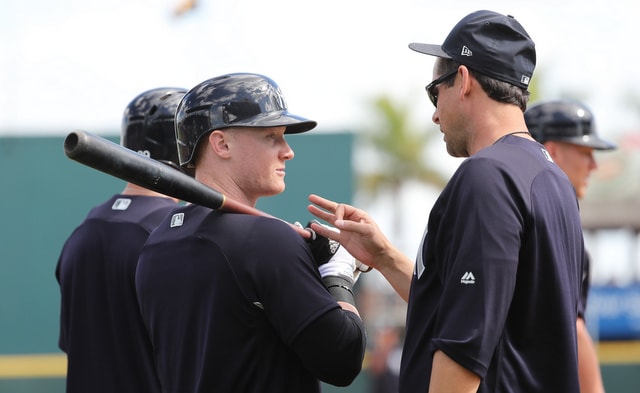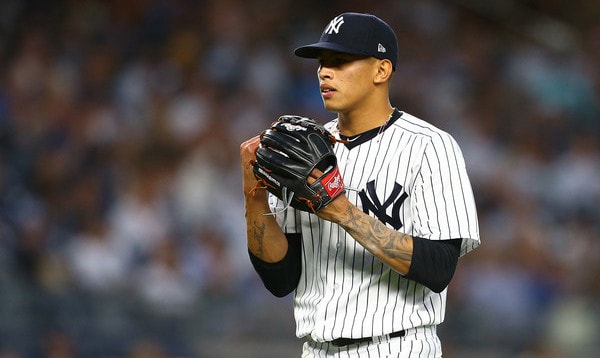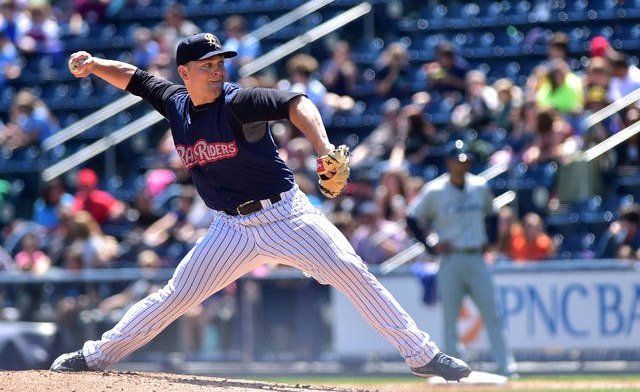
In the year 2019, exit velocity is firmly ingrained in the baseball lexicon. It is inescapable. It’s all over Twitter and game broadcasts, and the Yankees literally show exit velocity on the Yankee Stadium scoreboard. Each time a Yankee puts the ball in play, there’s the exit velocity, right next to the pitch velocity on the center field scoreboard. Get used to it. Exit velocity isn’t going anywhere.
The Yankees have embraced exit velocity as an evaluation tool. It helped them unearth Luke Voit, and I remember former farm system head Gary Denbo mentioning Aaron Judge had premium exit velocity back when he was still a prospect in the minors. Hit the ball hard and good things happen. Here is the 2018 exit velocity leaderboard (min. 200 balls in play):
- Aaron Judge: 94.7 mph
- Joey Gallo: 93.9 mph
- Nelson Cruz: 93.9 mph
- Giancarlo Stanton: 93.7 mph
- Matt Chapman: 93.1 mph
(MLB average: 87.7 mph)
Hitting the ball hard is a good skill to have. I mean, duh. Hit the ball hard and it’s more likely to go for a hit. Hit the ball hard in the air and it’s more likely to do serious damage, meaning extra-base hits. Last season the league hit .730 with a 1.098 ISO — that’s ISO, not SLG — on fly balls and line drives with an exit velocity of at least 100 mph. For real.
Not surprisingly, the home run record-setting Yankees led MLB with a 93.6 mph average exit velocity on fly balls and line drives last season. With that in mind, let’s look at where each projected member of the 2019 Yankees hit the ball the hardest last year. Specifically, let’s look at where in the strike zone they produce their best contact. Some guys are low ball hitters, others are high ball hitters, etc.
For the purposes of this post, we’re going to consider “best contact” to be fly balls and line drives with an exit velocity of at least 100 mph. Why 100 mph and not, say, 95 mph or 97.6 mph or whatever? No real reason. Round numbers are cool so 100 mph it is. Here is each projected 2019 Yankee, listed alphabetically, and last year’s “best contact” profile.
(All spray chart are shown with Yankee Stadium’s dimensions even though not every batted ball was hit at Yankee Stadium, which is why there appear to be more homers than were actually hit.)
Miguel Andujar

Average FB+LD exit velocity: 92.7 mph
Number of 100+ mph FB+LD: 65 (13.5% of all balls in play)
I am legitimately surprised Andujar’s exit velocity numbers are not better. His average exit velocity on all batted balls was 89.2 mph, which ranked 72nd among the 186 hitters with at least 300 balls in play last year. His average exit velocity on fly balls and line drives ranked 128th (!), right behind Manny Margot and one-tenth of a mile-an-hour better than JaCoby Jones. Huh. Didn’t expect that.
Anyway, the strike zone plot above shows Andujar makes hard contact pretty much everywhere. That makes sense. He seems to get the fat part of the bat on the ball no matter where it’s pitched. Most of his 100 mph or better fly balls and line drives are to the pull field, like most hitters, though Andujar can drive the ball the other way. I’m still a bit surprised his exit velocity are numbers are relatively low (but still better than average). Didn’t see that coming. Maybe that means he’s due for bad regression?





